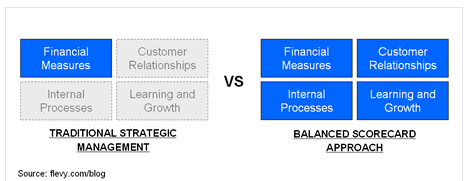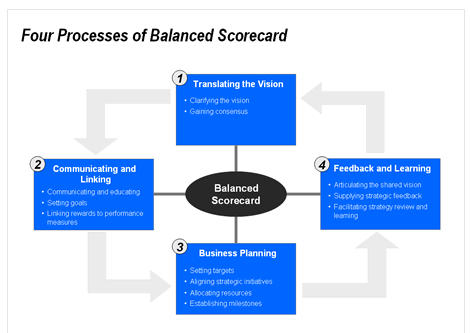Perform strategic management right with a Balanced Scorecard
It’s (relatively) easy to come up with a corporate vision, with a mission statement, with a set of strategies. But, when it comes to the execution of that vision and strategy, things become much more challenging. This difficulty increases as the size of the organization increases. For proper strategic performance management, a number of methodologies and tools exist. The best strategic management framework is still the Balanced Scorecard (BSC).
First, let’s define strategic management. Wikipedia states strategic management analyzes the major initiatives taken by a company’s top management on behalf of owners, involving resources and performance in external environments. It entails specifying the organization’s mission, vision and objectives, developing policies and plans, often in terms of projects and programs, which are designed to achieve these objectives, and then allocating resources to implement the policies and plans, projects and programs. It is a level of management activities below setting goals and above tactics.
The goal of every business is to make a profit. As such, corporate goals, initiatives, and investments all typically are tied to financial metrics. How will it impact sales? What is the ROI? How long is the payback? Resultantly, most strategic management systems focus on financial measures. The Balanced Scorecard differs in that it takes a “balanced” approach by supplementing traditional financial measures with three important non-financial categories:
- Customer Relationships
- Internal Business Processes
- Learning and Growth
This balanced approach allows organizations to track financial results, while simultaneously monitoring progress in building the capabilities and acquiring the intangible assets they need for continued, sustainable growth.

The foundation of the strategic management approach should be based on the BSC. With the scorecard and metrics in place, the organization should adopt a continuous, iterative approach to managing its strategy and BSC. Through this process, companies can achieve the following:
- Clarify and update the overall corporate strategy
- Communicate the strategy throughout the organization
- Align departmental and individual goals with the strategy
- Link strategic objectives to long-term targets and annual budgets
- Identify and align strategies initiatives; and
- Conduct periodic performance reviews to learn about and improve strategy
Properly implementing BSC requires an iterative set of four processes.
Process 1. Translating the Vision
The first process is to translate the vision. This involves converting the vision statement into operational terms. The process also ensures that, at the management level, we gain consensus and its true essence. Whereas gaining consensus may seem an easy and self-evident task, it often is not. Vision statements are often vague and easily interpreted differently by different people. In other words, even though everyone may agree to a vision statement, each person may have formed a different interpretation of what that statement actually refers to in operational terms.
Process 2. Communication and linking
The second involves communicating the translated vision down through the organization and educating people on what it means. It also involves setting objectives and linking rewards to performance metrics.
Process 3. Business planning
Business planning must then be performed in accordance to the work done in the previous two processes. Business planning activities include setting targets, aligning strategic initiatives, and allocation resources. In most companies, strategic planning and budgeting are two separate processes. BSC forces your organization to integrate the two processes.
Process 4. Feedback and learning
This fourth process provides a mechanism for strategic feedback and review. It allows for continuous strategic refinements. Info that can be tracked with the scorecard for this includes feedback on products, new learnings about internal processes, and technological discoveries.

As the diagram above illustrates, Feedback and Learning feeds back into Translating the Vision.
Of course, the approach to strategic management can be driven by the size of the organization. A global organization may employ a more structured strategic management model. This is due to its size, scope of operations, and need to encompass stakeholder views and requirements.
A small or mid-sized business may adopt an entrepreneurial approach. This is due to its comparatively smaller size and scope of operations, as well as possessing fewer resources. In such cases, the CEO may simply outline a mission, and pursue all activities under that mission.
The Balanced Scorecard approach becomes more useful and necessary as the size of the organization increases.

Hi, your strategic management and Balanced scorecard post is very interesting. I am new to this so forgive my ignorance. I work with small business owners and want to scale this system for them and have a template I can use for structuring the work we do. I want to create something but as my knowledge is very basic it is proving quite difficult. Reading your post, how exactly do the processes link into the BSC? I have the “Internal Business”, “Financial”, “Customer” and Learning & Growth headings but can’t see how that links to the 4 process steps in your post.
Thanks
Jo
Thank you, Jo. You can think of the 4 processes as the approach and the BSC as the output. Through this iterative approach, you are constantly updating and refining the BSC. You may find these documents helpful as well —
http://flevy.com/browse/business-document/balanced-scorecard-134
https://flevy.com/browse/business-document/opex-balanced-scorecard-deployment-567 (also contains a BSC template in Excel)